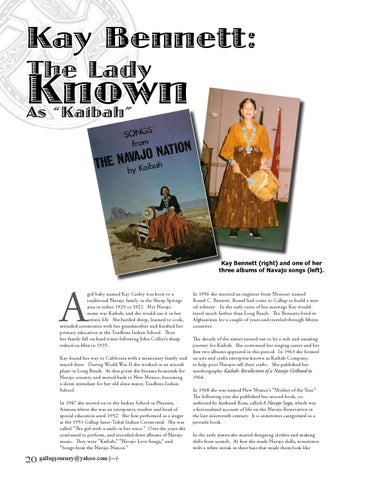Kay Bennett: The Lady
Known As “Kaibah”
Kay Bennett (right) and one of her three albums of Navajo songs (left).
A
girl baby named Kay Curley was born to a traditional Navajo family in the Sheep Springs area in either 1920 or 1922. Her Navajo name was Kaibah, and she would use it in her artistic life. She herded sheep, learned to cook, attended ceremonies with her grandmother and finished her primary education at the Toadlena Indian School. Then her family fell on hard times following John Collier’s sheep reduction blitz in 1935. Kay found her way to California with a missionary family and stayed there. During World War II she worked in an aircraft plant in Long Beach. At that point she became homesick for Navajo country and moved back to New Mexico, becoming a dorm attendant for her old alma mater, Toadlena Indian School. In 1947 she moved on to the Indian School in Phoenix, Arizona where she was an interpreter, teacher and head of special education until 1952. She first performed as a singer at the 1951 Gallup Inter-Tribal Indian Ceremonial. She was called “The girl with a smile in her voice.” Over the years she continued to perform, and recorded three albums of Navajo music. They were “Kaibah,” “Navajo Love Songs,” and “Songs from the Navajo Nation.”
20 gallupjourney@yahoo.com
In 1956 she married an engineer from Missouri named Russel C. Bennett. Russel had come to Gallup to build a new oil refinery. In the early years of her marriage Kay would travel much farther than Long Beach. The Bennetts lived in Afghanistan for a couple of years and traveled through fifteen countries. The decade of the sixties turned out to be a rich and amazing journey for Kaibah. She continued her singing career and her first two albums appeared in this period. In 1963 she formed an arts and crafts enterprise known as Kaibah Company, to help poor Navajos sell their crafts. She published her autobiography Kaibah: Recollection of a Navajo Girlhood in 1964. In 1968 she was named New Mexico’s “Mother of the Year.” The following year she published her second book, coauthored by husband Russ, called A Navajo Saga, which was a fictionalized account of life on the Navajo Reservation in the late nineteenth century. It is sometimes categorized as a juvenile book. In the early sixties she started designing clothes and making dolls from scratch. At first she made Navajo dolls, sometimes with a white streak in their hair that made them look like
